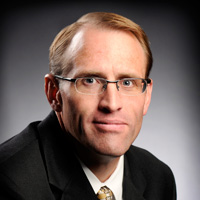Invest with Your Eyes Wide Open
Are you prepared for volatility? Before you make an investment, look carefully at its track record by asking these five questions.


Many investors are convinced that their investment portfolios should always go up. When returns don’t meet these unrealistic expectations, they tend to throw in the towel. It’s a mistake to sell good investments just because they are having a sluggish year or struggling through a bear market. You need to invest with your eyes wide open, knowing beforehandwhat to expect from your investments in both bull and bear markets. In most cases, when your investments take near-term dips, or fluctuate with the market, you should stay invested and hold on.
Most investors ask only one question before buying a portfolio of investments: “What will my return be?” Usually, they answer this by looking at recently posted one-year returns. Stopping at this question will likely leave you disappointed at some point during your investment journey.
In addition to knowing what the returns of your investments have been recently, be sure to ask the following:
From just $107.88 $24.99 for Kiplinger Personal Finance
Become a smarter, better informed investor. Subscribe from just $107.88 $24.99, plus get up to 4 Special Issues

Sign up for Kiplinger’s Free Newsletters
Profit and prosper with the best of expert advice on investing, taxes, retirement, personal finance and more - straight to your e-mail.
Profit and prosper with the best of expert advice - straight to your e-mail.
- What has the portfolio returned on average over the past one, three, five and 10 years?
- What was the best and worst three-month period during the past 10 years?
- What was the best and worst one-year period during the past 10 years?
- What was the best and worst three-year period during the past 10 years?
- How has the investment performed during past wars, bear markets, terrorist attacks and elections?
As an example, let’s answer these questions assuming you had a moderate portfolio consisting of 75% stocks and 25% bonds, such as a combo of Vanguard Total Stock Market Index Fund (Ticker: VTSMX) and Vanguard Total Bond Market Index Fund (VBMFX), rebalanced annually. You would have enjoyed an average return of 11.98%, 7.43%, 11.14%, and 7.06% over the past one, three, five and 10 years (according to Morningstar) for the period ending 8/31/2017. However, to obtain that 7.06% 10-year return you would have had to endure a worst three-month period watching the portfolio fall 23.45%, a worst one-year period with a drop of 32.03%, and a three-year period that lost 3.98% per year. For the 10-year period ending 8/31/2017, a $500,000 investment into this portfolio would now be worth $999,194.
Once you know the answers to these questions, you can then ask yourself an even more significant question: “If I want the long-term returns this investment or portfolio can produce, can I withstand the volatility?”
Without understanding this risk from the onset, volatility will likely get the best of you somewhere down the road.
Let’s investigate the market’s ups and downs during different periods.
The chart below compares eight different investors. All began investing on Jan. 1, 2008, with $500,000. The first four investors took withdrawals of $20,000 per year starting in 2008. The last four investors didn’t take any withdrawals. You’ll notice how much their portfolios fell in 2008-09 and how long it took to get back to $500,000. Based on this chart you can ask yourself which portfolio is closest to yours and whether or not you could handle similar volatility in the future. This was a really poor period in market history, however, you’ll notice that all the portfolios rebounded after 2008 and went on to provide modest returns.

Remember to take downturns in context. Listed below are the worst one-year results for different segments of the stock and bond markets from 1970 to 2016. For example, during the 1973–1974 recession, large-company stocks fell 37%. An investor would have been shortsighted to have sold a portfolio of large-company stocks after these poor-performing years. In thefollowing two years (1975–1976), large-company stocks provided patient investors with 37% and 24% returns, respectively. A $10,000 investment in an S&P 500-stock index fund starting in January 1970 would have grown to $1,002,783 by December 2016, a return of 10.30% per year.
Risk and Return of the Stock and Bond Markets
| 1970-2016 | ||
|---|---|---|
| Asset Class | Annual Rate of Return | Worst Year |
| Large-Company U.S. Stocks | 10% | -37% |
| Small-Company U.S. Stocks | 12% | -38% |
| International Stocks | 9% | -43% |
| Long-Term Corporate Bonds | 9% | -7% |
| Long-Term Government Bonds | 9% | -12% |
| U.S. Treasury Bills | 5% | 0.03% |
Let’s examine risk further by looking at drops occurring during market downturns, wars and terrorism. Again, the question in mind is: If we had similar volatility in the future, could I handle it?
Market Downturns
| S&P 500 Index | ||||
|---|---|---|---|---|
| Market Downturn | Row 0 - Cell 1 | Total Months | Total Return S&P 500 | Total Return One Year Later |
| Begin | End | Row 1 - Cell 2 | Row 1 - Cell 3 | Row 1 - Cell 4 |
| Jun 15 '48 | Jun 13 '49 | 12.1 | -20.6% | 42.1% |
| Aug 2 '56 | Oct 22 '57 | 14.9 | -21.5% | 31.0% |
| Dec 12 '61 | Jun 25 '62 | 6.5 | -27.8% | 32.3% |
| Feb 9 '66 | Oct 7 '66 | 8 | -22.2% | 33.2% |
| Nov 29 '68 | May 26 '70 | 18.1 | -36.1% | 43.7% |
| Jan 11 '73 | Oct 3 '74 | 21 | -48.2% | 38.0% |
| Nov 28 '80 | Aug 12 '82 | 20.7 | -27.1% | 58.3% |
| Aug 25 '87 | Dec 4 '87 | 3.4 | -33.5% | 22.8% |
| Mar 24 '00 | Sep 21 '01 | 18.2 | -36.8% | -13.7% |
| Jan 4 '02 | Oct 9 '02 | 9.3 | -33.8% | 33.7% |
| Oct 9 '07 | Nov 20 '08 | 13.6 | -51.9% | 45.0% |
| Jan 6 '09 | Mar 9 '09 | 2.1 | -27.6% | 68.6% |
| Average | Row 14 - Cell 1 | 12 | -32.3% | 36.2% |
War
| Dow Jones Industrial Average (DJIA) | Header Cell - Column 1 | Header Cell - Column 2 | Header Cell - Column 3 | Header Cell - Column 4 |
|---|---|---|---|---|
| War | Begin | End | Total Months | Change in DJIA |
| World War l | Apr '17 | Nov '18 | 20 | -19% |
| World War ll | Dec '41 | Aug '45 | 45 | 41% |
| Korean War | Jun '50 | Jul '53 | 37 | 20% |
| Vietnam War | Aug '64 | Jan '73 | 102 | 21% |
| Gulf War | Jan '91 | Feb '91 | 2 | 15% |
| Iraq War | Mar '03 | Dec '11 | 105 | 43% |
| Average | Row 7 - Cell 1 | Row 7 - Cell 2 | 52 | 20% |
Terrorism on U.S. Soil
| S&P 500 Index | ||
|---|---|---|
| Attacks of September 11, 2001 | Days after Attack | Total Return S&P 500 |
| Initial Market Reaction September 17, 2001 | 7 | -4.9% |
| Market Bottom after Attack September 21, 2001 | 11 | -11.6% |
| One Month after Attack October 11, 2001 | 30 | 0.4% |
| Two Months after Attack November 10, 2001 | 60 | 2.5% |
| Three Months after Attack December 10, 2001 | 90 | 4.3% |
Despite all the recessions, wars, terrorist attacks and market crashes, the stock market has been an excellent investment over the long term. The key is to stay invested through thick and thin. When you invest in a portfolio of stocks and bonds, be aware of the potential upside and downside associated with your investments. If you don’t understand the risks at the outset, youare more likely to react poorly during periodic market setbacks and get scared out of the market.
At the outset when you buy an investment, you should plan on worst-case scenarios occurring at some point. If you understand the risk from the beginning, you are more likely to stay invested for the long term and realize solid long-term gains. It is true that past performance isn’t guaranteed to repeat, but it does give us a historical indication of what to expect.
Profit and prosper with the best of Kiplinger's advice on investing, taxes, retirement, personal finance and much more. Delivered daily. Enter your email in the box and click Sign Me Up.

Ray LeVitre is an independent fee-only Certified Financial Adviser with over 20 years of financial services experience. In addition he is the founder of Net Worth Advisory Group and the author of "20 Retirement Decisions You Need to Make Right Now."
-
 Your Guide to Buying Art Online
Your Guide to Buying Art OnlineFrom virtual galleries to social media platforms, the internet offers plenty of places to shop for paintings, sculptures and other artwork without breaking the bank.
-
 Samsung Galaxy S25 Ultra for $4.99 a Month: A Closer Look at Verizon’s Deal
Samsung Galaxy S25 Ultra for $4.99 a Month: A Closer Look at Verizon’s DealVerizon’s aggressive pricing makes Samsung’s top-tier phone tempting, but the real cost depends on your plan and how long you stay.
-
 I'm 59 with $1.7 million saved and lost my job. Should I retire?
I'm 59 with $1.7 million saved and lost my job. Should I retire?We asked professional wealth planners for advice.
-
 A Wealth Adviser Explains: 4 Times I'd Give the Green Light for a Roth Conversion (and 4 Times I'd Say It's a No-Go)
A Wealth Adviser Explains: 4 Times I'd Give the Green Light for a Roth Conversion (and 4 Times I'd Say It's a No-Go)Roth conversions should never be done on a whim — they're a product of careful timing and long-term tax considerations. So how can you tell whether to go ahead?
-
 A 4-Step Anxiety-Reducing Retirement Road Map, From a Financial Adviser
A 4-Step Anxiety-Reducing Retirement Road Map, From a Financial AdviserThis helpful process covers everything from assessing your current finances and risks to implementing and managing your personalized retirement income plan.
-
 The $183,000 RMD Shock: Why Roth Conversions in Your 70s Can Be Risky
The $183,000 RMD Shock: Why Roth Conversions in Your 70s Can Be RiskyConverting retirement funds to a Roth is a smart strategy for many, but the older you are, the less time you have to recover the tax bite from the conversion.
-
 A Financial Pro Breaks Retirement Planning Into 5 Manageable Pieces
A Financial Pro Breaks Retirement Planning Into 5 Manageable PiecesThis retirement plan focuses on five key areas — income generation, tax management, asset withdrawals, planning for big expenses and health care, and legacy.
-
 4 Financial To-Dos to Finish 2025 Strong and Start 2026 on Solid Ground
4 Financial To-Dos to Finish 2025 Strong and Start 2026 on Solid GroundDon't overlook these important year-end check-ins. Missed opportunities and avoidable mistakes could end up costing you if you're not paying attention.
-
 Are You Putting Yourself Last? The Cost Could Be Your Retirement Security
Are You Putting Yourself Last? The Cost Could Be Your Retirement SecurityIf you're part of the sandwich generation, it's critical that you don't let the needs of your aging parents come at the expense of your future.
-
 I'm an Insurance Pro: It's Time to Prepare for Natural Disasters Like They Could Happen to You
I'm an Insurance Pro: It's Time to Prepare for Natural Disasters Like They Could Happen to YouYou can no longer have the mindset that "that won't happen here." Because it absolutely could. As we head into 2026, consider making a disaster plan.
-
 The Future of Philanthropy Is Female: How Women Will Lead a New Era in Charitable Giving
The Future of Philanthropy Is Female: How Women Will Lead a New Era in Charitable GivingWomen will soon be in charge of trillions in charitable capital, through divorce, inheritance and their own investments. Here's how to use your share for good.